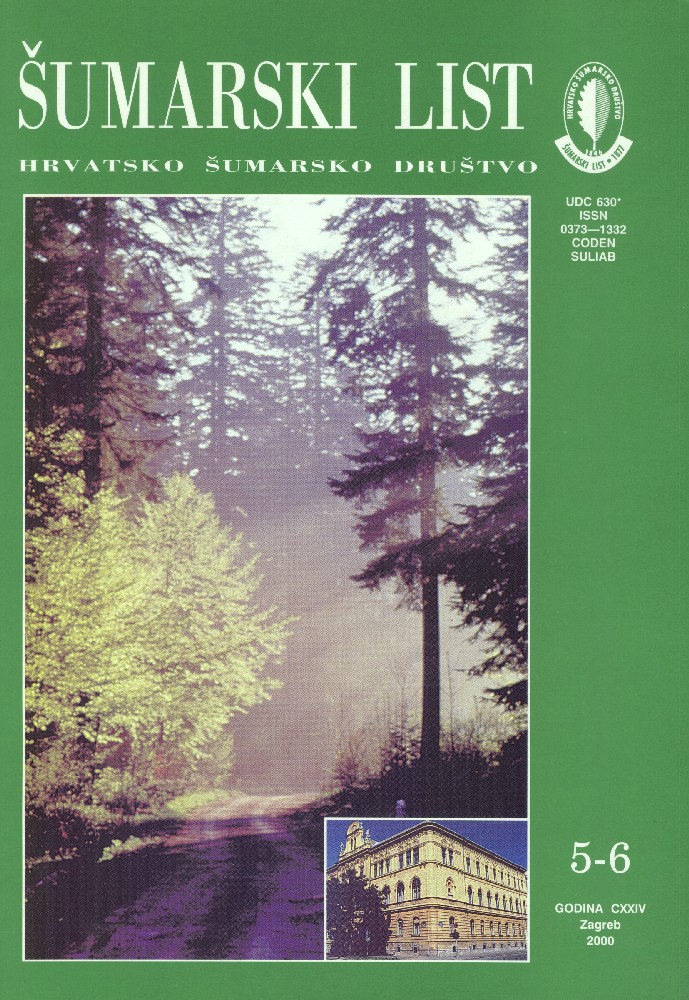
broj: 5-6/2000
pdf (28,1 MB) |
|
||||||||||||||
| IZVORNI ZNANSTVENI ČLANCI | ||
| Idžojtić, M. | UDK 630* 160 (Pinus sp.) 001. | |
| Composition of Volatiles from Needles of Pinus sylvestris L., P. nigra Arnold, P. densiflora Sieb. et Zucc. and P. thunbergiana Franco pdf HR EN | 263 | |
| Summary: The composition of needle volatiles of Scots pine (Pinus sylvestris L. = sy), European black pine (P. nigra Arnold = ni), Japanese red pine (P. densiflora Sieb. et Zucc. = de) and Japanese black pine (P. thunbergiana Franco = th) was investigated with gas chromatography (GC) and gas chromatography/mass spectrometry (GC/MS).The number of detected components differs for individual species (European black pine 122, Scots pine 116, Japanese red pine 122, Japanese black pine 87). A total of 55 components was identified. The identified components accounted for 90.1 % w/w sample of Scots pine, 94.4 % w/w sample of European black pine, 81.3 % w/w sample of Japanese red pine and 94.9 % w/w sample of Japanese black pine. All identified components were terpenes, except trans-2-hexenal, which is n-alkene. The amount of monoterpenes was the highest (sy 54.3 %, ni 64.9 %, de 61.7 %, th 77.3 %), followed by sesquiterpenes (sy 35.5 %, ni 27.1 %, de 13.6 %, th 16.4 %) and diterpenes (sy 0.2 %, ni 2.3 %, de 5.9 %, th 0.73 %). In terms of the composition of needle essential oil, P. sylvestris, P. nigra, P. densiflora and P. thunbergiana do not differ qualitatively, but their quantitative difference is considerable. The components that are specific for Scots pine are D3-carene and endo-1-bourbonanol. Germacrene D is characteristic for European black pine, thunbergol for Japanese red pine, and b-pinene for Japanese black pine. These components occur in a significantly higher amount in essential oils of the mentioned species than in those of other analysed species. Of all the components present in the needle essential oils, the amount of a-pinene is the highest in Scots pine, European black pine and Japanese red pine (sy 32.9 %, ni 42.7 %, de 25.8 %), while that of b-pinene is the highest in Japanese red pine (34.1 %). It has been shown with cluster analysis that Scots pine and Japanese red pine are the most similar in terms of needle essential oil composition. European black pine is similar to them, while Japanese black pine differs considerably from the other three analysed species. Key words: cluster analysis.s; essential oils; GC; GC/MS; P. densiflora Sieb. et Zucc.; P. nigra Arnold; P. thunbergiana Franco; Pinus sylvestris L.; terpenes | ||
| Ballian, D. | UDK 630* 165 + 232.3 (Prunus avium L.) 001. | |
| First Study on the Variability of Morphological Characteristics of Wild Cherry (Prunus avium L.) Seeds pdf HR EN | 271 | |
| Cvjetan, S., Kajba, D., Pavičić, N., Pejić, I. | UDK 630* 165 (Cupressus sempervirens L.) 001. | |
| Genetic Analysis of the Old Cypress of Hvar (Cupressus sempervirens var. horizontalis (Mill.) Gord. pdf HR EN | 279 | |
| Krapinec, K., Vukelić, J., Grubešić, M. | UDK 630* 451 + 156 (001) | |
| A Contribution to Insights Into Crack Phillyrea (Phyllirea latifolia L.) Browsing by Wild Ruminants on the Island of Rab pdf HR EN | 285 | |
| PREGLEDNI ČLANCI | ||
| Sabadi, R. | UDK 630* 904 | |
| France: Forests of the Overseas Departments pdf HR EN | 293 | |
| Gračan, J. | UDK 630* 425 | |
| Trends in Impacts of Long-Range Transboundary Air Pollution pdf HR EN | 303 | |


